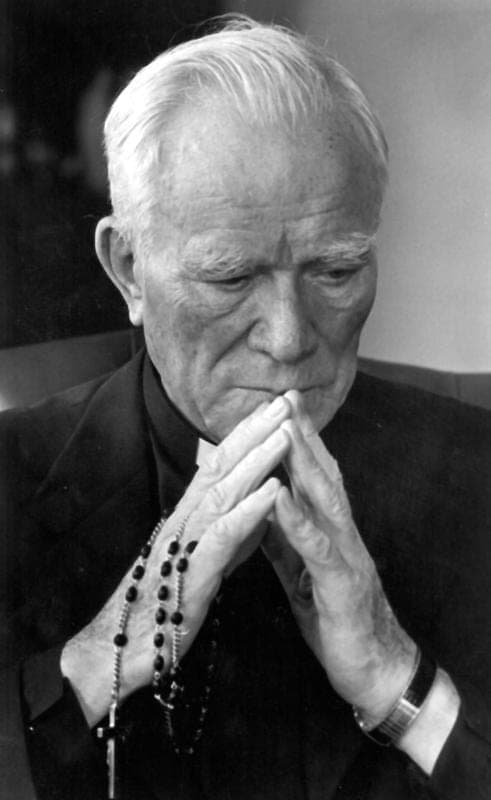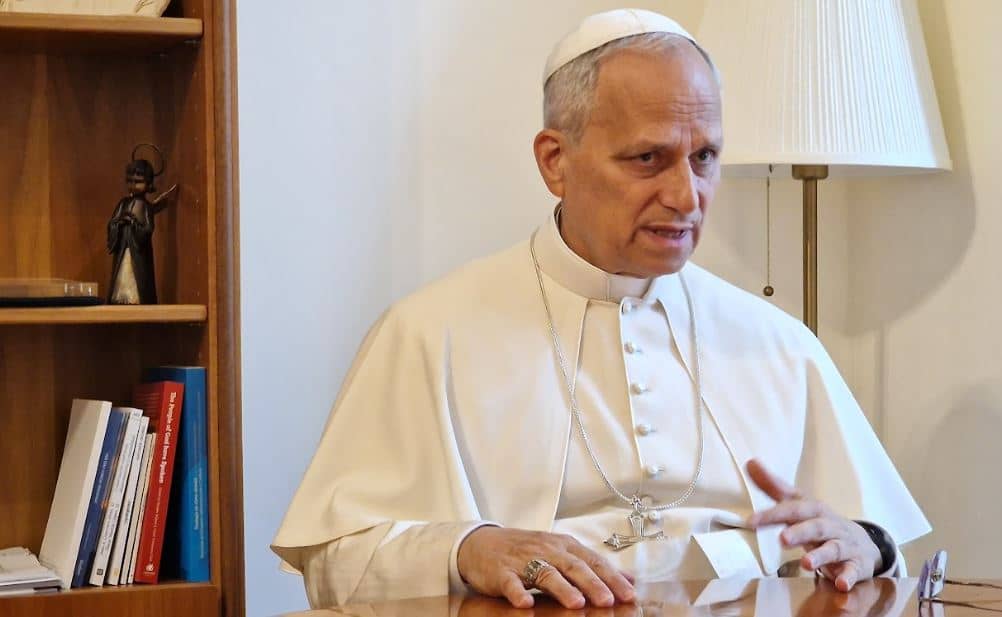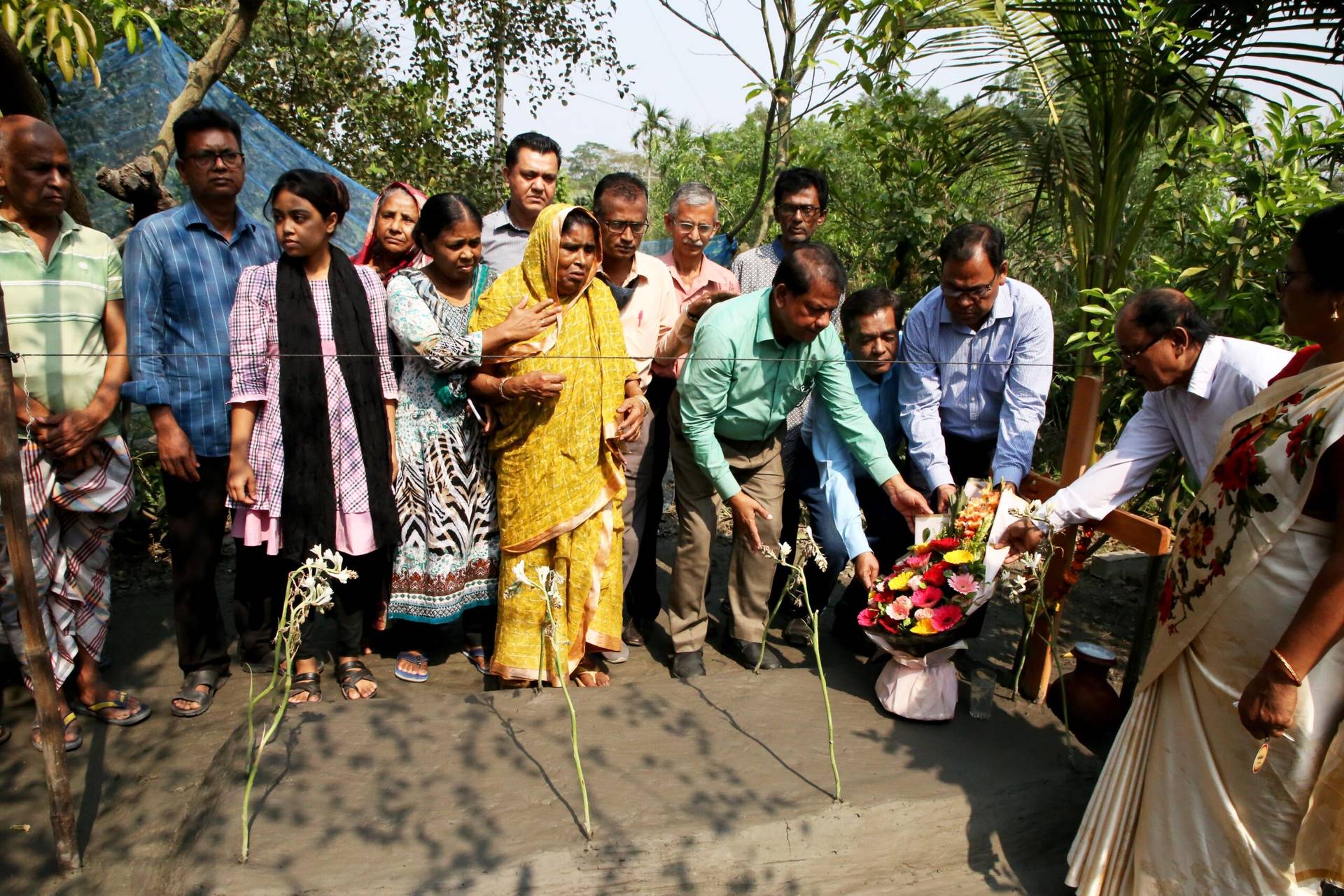[Holy Cross Father Steve Gibson is the head of the Father Patrick Peyton, CSC Memorial Centre in County Mayo, Ireland. Peyton, who died in 1992, was known as the “Rosary Priest” and promoted the family rosary. Famous for the phrase “the family that prays together stays together,” his Family Rosary Crusades drew some of the largest crowds in history. Pope Francis named him “Venerable” in 2017, the first major step on the road to sainthood. Gibson spoke to Charles Camosy.]
Camosy: Some readers will know that the Holy Cross priests, brothers, and sisters founded the University of Notre Dame, St. Mary’s College, and Holy Cross College. But I think many would be interested to know a bit more about the order beyond that. Can you give us some highlights?
Gibson: Like so many other congregations, our congregation was founded in France just after the French Revolution to help rebuild the educational system that had collapsed because of the war. Our founder was a great believer in Divine Providence, and it did not take long before his small community was sending its members to foreign missions in Africa, the Americas, and Asia – and that same spirit is alive today as we look at all the places where the congregation ministers across the globe.
The number of indigenous religious that we have in India and Bangladesh, Uganda, Tanzania, Kenya and Ghana, Mexico, Peru, Chile, Haiti and Brazil is ever increasing. The responsibility for the leadership for all the schools and parishes that we have in these areas has thankfully been assumed by the local members of each of those places.

Our Constitution says that we are people “With Hope to bring.” You do not need to look far to find people who have a need for this Hope. The word “Crux” and the word “Hope” are in the very motto of the congregation: Ave Crux, Spes Unica: The Cross, Our only Hope.
“How do we tell people that God loves them, when the circumstances in which they find themselves does not seem to indicate that?” This question can be asked about our ministry not only to the poorest of the poor but about anyone who walks on the face of the earth.
We all hope to be able to find ourselves in a circumstance that would let us know that God loves us. Education is certainly one of the ways that we come to know our place in the world and in society. We members of Holy Cross are proud of our parishes and educational institutions in almost every corner of the world. To be an instrument that helps people to open their minds to see the good that is all around them is a great gift and responsibility. As educators in the Faith this process is carried out in all the ministries in which we are involved.
And that worldwide reach of the Holy Cross order is indicated by where you work: The Father Patrick Peyton, CSC Memorial Centre in County Mayo, Ireland. Can you tell us more about Father Peyton and why the center was named after him?
There was a time in the 1950s and ’60s when it seemed like the whole world knew the name of Father Patrick Peyton. He was known as “the rosary priest.” But he was actually so much more than that. His involvement with the stars of Hollywood, who helped produce his programs on family values, is well documented. And in the worldwide rosary rallies he spoke to an estimated 27 million people.
What is always overlooked, however, is the effort that went into all of this. He did not just put a notice in the Sunday Bulletin and a million people would show up. He involved people on every level: from national episcopal conferences, to dioceses, to parishes, to schools, to neighborhoods, to homes, to individuals. It was a movement and an organization that took years to execute.
It is a good model for the whole church and how people on every level need to work together and be involved in the spread of our faith. The Fr. Peyton Memorial Centre here in Ireland was established in the village from which he came but it is more than just a museum. We try to continue his mission to help families pray.
Father Peyton stood in front of the large crowds who came to hear him speak not just about his devotion to Our Lady. He spoke passionately to men saying: “Men, be the best man you can be, and the best husband, the best father. And teach your sons how to be good men, husbands and fathers.”
And to the women he said: “Women, be the best wives and mothers that you can be and teach your daughters how to be good wives and mothers.”
We echo that same message in everything that we do.
I remember you so well from the days when you ran retreats at Our Lady of Fatima Retreat Center at Notre Dame. What are you doing now with the Fr. Peyton Centre? Similar kinds of things?
Here at the Fr. Peyton Centre we provide services to the local community that include: Meals on Wheels for the homebound and school lunches for the primary school.
We have a wonderful weekly program for senior citizens for which they come together for Mass and a meal and some form of entertainment afterwards: Bingo or dancing or presentations on health and welfare. For many of them it is the only time that they get out of the house.
The church documents that teach us about the Eucharist indicate that Christ is first present in the assembly, then the Word, and then the breaking of the bread. It is easy to see His presence as you watch the people come from the rural transport buses and come into the building and greet one another with such joy and enthusiasm. This is “Church” as much as anything that I have seen anywhere.
We also have a vibrant youth ministry program that reaches out to as many as five different Dioceses so far.
It would not be uncommon to have a day program for high school students on Monday, senior citizens on Tuesday, a first Holy Communion class on Wednesday, a pilgrimage group on a religious tour of Ireland on Thursday, a confirmation class on Friday, and a memorial Mass for a family member on Saturday. We also have wake services for which hundreds and hundreds of people would attend to show their support for the family.
It sounds like you have a robust operation there which indicates a vibrant Church community in the area. Most of the news we get here in the United States about the Church in Ireland is not very hopeful. Does your on-the-ground experience lead you to a more complicated view?
The image that we have today of the Catholic Church in Ireland is indeed very different from what we saw in some of the old nostalgic Hollywood movies. It is true that many of the things that we find in the media paint a rather dim picture of the Church. But maybe they are helping us to find a new canvas and to paint a new and vibrant picture that takes advantage of some of the goodness that is inherent in this culture.
I can only speak of the experience that I have had in one very small part of rural Ireland but there is something extraordinary in the devotion or obsession that people here have for family.
One of the most moving examples of this was something that we saw at the end of the [British Open] golf tournament. An Irish golfer was winning one of the most prestigious tournaments in the world. This Irishman made his way along the eighteenth fairway of an Irish golf course, lined with thousands of cheering Irish supporters. When he sank his final putt and held up the Claret Jug as a sign that he had just beaten the best golfers in the world he pointed at it and said, “This is great…” then pointing to his young child in the other arm said, “but this is better.” And I think everyone agreed with him.
There is something about family and the strong position that it holds in the Irish culture that Father Peyton capitalized on. The experience of family prayer that was such a big part of his upbringing is the experience that he took to the four corners of the world.
That passion for family is still there. It may not manifest itself as it used to in the recitation of the rosary or in attendance at Sunday Mass. But it is still there. We see it at a wake service or at memorial celebrations for deceased family members. We see it at weddings and baptisms. Are we doing enough to take advantage of the few opportunities that we may have to find ways to minister to these “occasional” Catholics? Let’s find more “occasions” to celebrate with the families that we already have.
You’ve now spent extended, often intimate time with thousands and thousands of Catholics from all over the United States and Ireland. Indeed, I know from personal experience that you’ve been present for and often facilitated life-changing moments for them. Based on this experience, what advice do you have to give those of us who want to help bring the Gospel to a hurting and alienated culture?
The Gospel is sometimes a real puzzle. I love puzzles. When you finally put that last piece in, there is a sense of peace and accomplishment that is very satisfying.
The puzzling thing about the Gospel is that some things just don’t seem to fit together. We can easily find ourselves picking and choosing what pieces to use for our particular puzzle. We choose not to “pluck out our eye or cut off our hand,” imagining that “he must be kidding.”
Maybe He was just exaggerating to make a point. Maybe He was just kidding when He told us to “Love your enemies”, “Walk the second mile”, “Turn the other cheek.”
How do we pick and choose?
We can’t just throw away the pieces that we don’t want. The picture would not be complete. But when it is complete and we see the whole thing as it was meant to be, what we will find before us is a God who loves us. We will find a God who wants us to do what we do because it is the right thing to do, not because we are afraid of the consequences if we do not. If we do not allow ourselves to be manipulated by fear, we will find a peace in our soul that enriches us for doing the right thing for the right reason. We might even call that the Peace of Christ.
When the priest turns to us at Mass and says, “The Lord is with you,” we should not just mumble back some unenthusiastic “and also with you.” When he says, “The Lord is with you,” we should jump up out of our seats, throw our hands up in the air and shout, “I know. Isn’t it great?”
He really is with us. And he is going to see us through all of this. And we have to be willing to accept that it may not look like the Church of more recent times. Maybe it has to look more like the Church of the women and men who walked with Him and talked with Him and came to recognize Him, not in their theological discussions but around the table where they ate with their family and friends. Let’s go back there and try it again. That is what we are trying here.
















